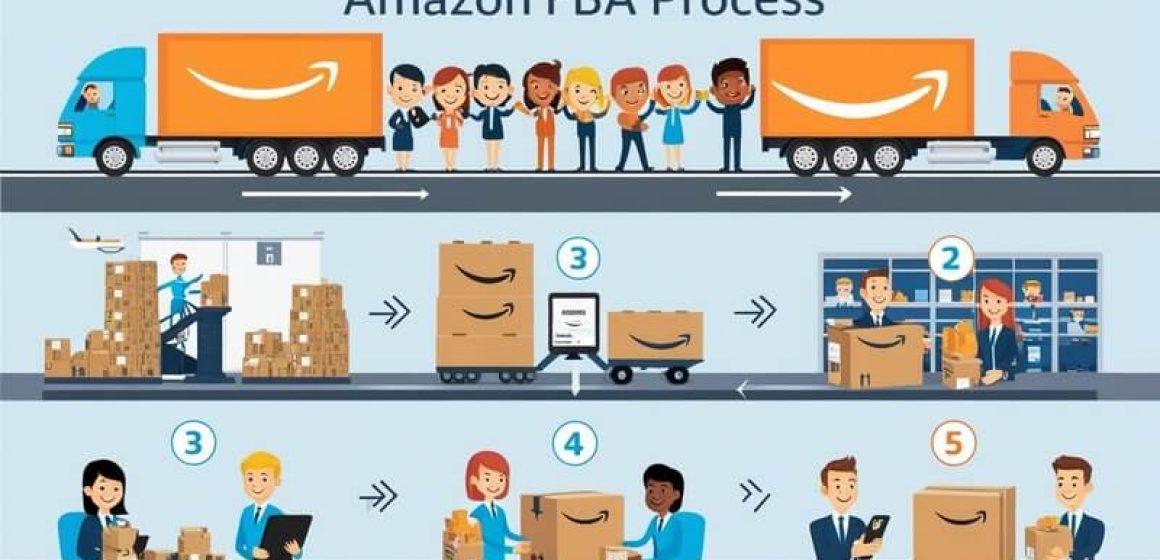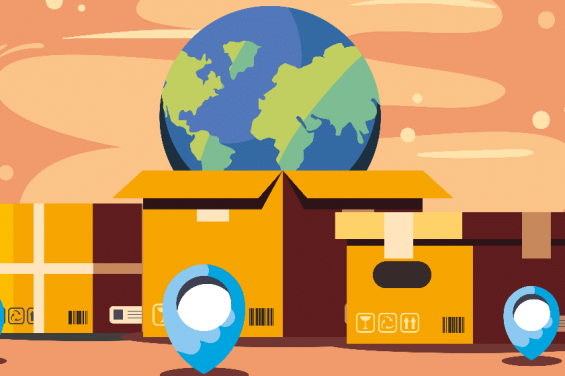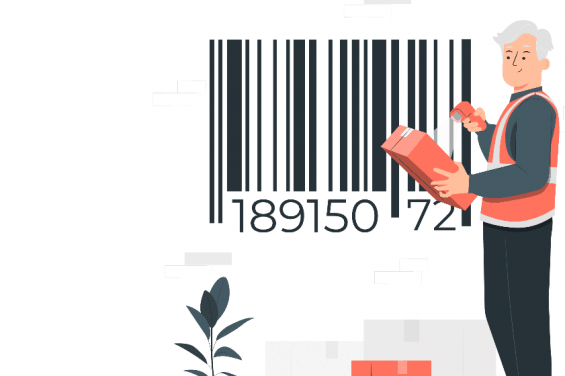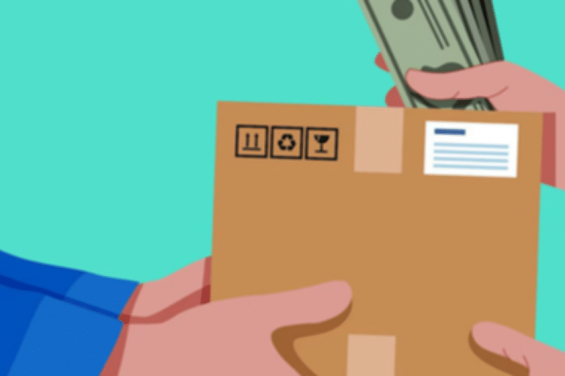Amazon FBA (Fulfillment by Amazon) is a service where Amazon stores, picks, packs, and ships your products directly to customers — and even handles returns. As a seller, you focus on sourcing and marketing, while Amazon handles the heavy lifting of logistics.
What Does Amazon FBA Stand For?
Amazon FBA stands for Fulfillment by Amazon. It’s a program where Amazon handles the storage, packing, shipping, and even customer service for products you sell through their platform. Instead of sending orders yourself, you ship your inventory to Amazon’s warehouse — and they take it from there.
The Full Meaning Behind “FBA”
- F = Fulfillment: This refers to the entire process of getting your product to the customer — picking, packing, shipping, and returns.
- B = By
- A = Amazon: Amazon’s powerful logistics network and Prime delivery system handle the operations for you.
To put it simply: You sell it, Amazon ships it.
What Most Sellers Don’t Realize About FBA
While Amazon technically takes over once your inventory reaches their fulfillment center, that’s not where your logistics journey begins.
Here’s what we see every day at FBABEE:
Most sellers source their products from manufacturers in China (Yiwu, Shenzhen, Fujian, etc.). That means their first challenge is getting goods from the factory floor to Amazon’s warehouse — a process we call “first-leg shipping” or “first-mile freight”.
This step is critical, because:
- Amazon has strict delivery appointment systems
- Incorrect carton labeling or invoice documentation can cause warehouse rejection
- Delays during peak seasons (e.g., Q4 or Chinese New Year) can ruin launch plans
If you don’t get the first mile right, Amazon FBA can quickly become frustrating — and expensive.
Common Misconceptions About FBA
- “FBA is a business model”
Actually, FBA is a logistics service, not a business model. You can run private label, wholesale, retail arbitrage, or dropshipping businesses — and still use FBA. - “FBA is only for big brands”
Thousands of small and solo sellers use FBA every day. It’s designed to scale with your business.
Recommended External Resource
To see Amazon’s official description of FBA, check out their program page here:
👉 https://sell.amazon.com/fulfillment-by-amazon
How Does Amazon FBA Work? (Step-by-Step)
Amazon FBA isn’t just one service — it’s a multi-step logistics engine that takes over once your inventory enters their network. Here’s a breakdown of how it works, from a seller’s point of view:
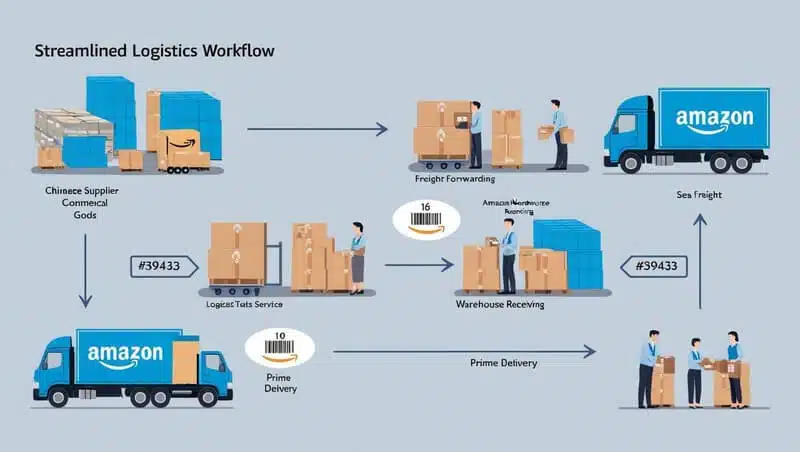
Step 1: You Ship Your Inventory to Amazon
Before anything goes live on Amazon, you need to prepare and ship your inventory to a designated Amazon fulfillment center.
Here’s what most people don’t tell you:
Amazon doesn’t help with this step — and it’s where most beginner mistakes happen.
At FBABEE, we help sellers coordinate everything from factory pickups in Yiwu or Shenzhen, to labeling, palletizing, and freight forwarding.
This part is known as first-leg logistics, and it’s often the most complex phase of FBA.
FBABEE Insight:
We’ve seen sellers cut prep and freight delays by 3–5 days just by consolidating products before customs clearance — especially during Q4 or pre-CNY rush.
Step 2: Amazon Receives and Stores Your Inventory
Once Amazon receives your goods, they:
- Scan and check your cartons
- Allocate products to one or more FCs (fulfillment centers)
- Store them until a customer orders
⚠️ Important: Inventory may be split between multiple locations, so plan your logistics to reduce multi-warehouse shipments — it saves time and money.
Step 3: A Customer Places an Order
When a buyer clicks “Buy Now”, Amazon’s system routes the order to the closest warehouse holding your product.
Step 4: Amazon Picks, Packs, and Ships the Product
Amazon’s staff picks the item from the shelf, packages it using their standard materials (unless you’re using custom packaging), and ships it via Prime or other delivery methods.
Pro Tip: If your product is fragile or bundled, always test your packaging beforehand. Damaged items lead to poor reviews and higher return rates.
Step 5: Amazon Handles Customer Service and Returns
Amazon also takes care of:
- Buyer emails and inquiries
- Refund requests
- Returned inventory inspections
This is one of FBA’s biggest advantages — you don’t need a customer service team.
Recommended YouTube Video
Here’s a solid visual walkthrough of the FBA process by JungleScout (2024):
👉 https://www.youtube.com/watch?v=5IhLzQkQEG8
Why Do Sellers Use Amazon FBA?
FBA isn’t just a convenience — for many sellers, it’s a scalable growth tool. By outsourcing the hardest parts of ecommerce (storage, shipping, returns), you can focus on what actually moves the needle: finding the right products and growing your brand.
Let’s break down the real reasons sellers choose FBA.
1. Fast, Reliable Prime Shipping
Products fulfilled by Amazon automatically get the Prime badge, which means:
- Free 1–2 day delivery in most regions
- Increased trust and higher conversion rates
- Eligibility for Prime-exclusive deals
Industry Insight:
According to a 2024 survey by JungleScout, listings with the Prime badge convert up to 38% better than non-Prime listings.
2. Amazon Handles Customer Service
Instead of spending hours responding to refund requests or tracking down lost packages, Amazon handles:
- Buyer messages
- Returns and refunds
- Delivery complaints
For solo or small team sellers, this saves time — and reduces burnout.
3. Access to a Global Logistics Network
When you use FBA, you tap into Amazon’s massive infrastructure:
- Dozens of FCs (Fulfillment Centers) in the U.S.
- Cross-border fulfillment options
- Automated multi-channel fulfillment
This kind of reach would take years (and millions) to build on your own.
4. You Can Focus on Growth, Not Operations
Here’s what we see at FBABEE all the time:
Sellers who offload prep and logistics to Amazon (or a partner like us) are able to:
- Launch new products faster
- Run better ad campaigns
- Expand into new marketplaces
They’re not stuck in the day-to-day. They’re building a business.
5. Easier to Win the Buy Box
Amazon’s algorithm favors listings that:
- Ship fast
- Have strong seller metrics
- Use FBA or SFP (Seller Fulfilled Prime)
In competitive niches, FBA can give you an algorithmic edge.
Mistake to Avoid
Don’t assume FBA is “set it and forget it.” You still need to:
- Monitor inventory levels
- Forecast restocks
- Avoid long-term storage fees
Pros and Cons of Amazon FBA
FBA offers massive convenience — but it’s not perfect. Over the years helping sellers navigate logistics from China to Amazon, I’ve seen both sides of the coin.
Here’s a breakdown of the real pros and cons based on experience.
✅ Pros of Using Amazon FBA
1. Prime Eligibility Increases Sales
Your products qualify for Amazon Prime, which boosts buyer confidence and improves conversion.
According to JungleScout’s FBA performance data, Prime-tagged listings can convert up to 38% higher than those without it.
2. Amazon Handles Customer Service
No emails, no refunds, no angry customers at midnight — Amazon’s team handles it all.
3. Scales as You Grow
FBA works whether you’re sending 50 units or 5,000. The infrastructure is already there.
4. Access to Amazon’s Shipping Network
Instead of building your own warehouse and fulfillment system, you plug into Amazon’s. That saves both time and capital.
5. Easy to Enter Global Markets
With the right setup, you can sell across Amazon marketplaces (US, Europe, etc.) — especially if your logistics partner helps with customs and prep.
⚠️ Cons of Using Amazon FBA
1. It’s Not Really Plug-and-Play
While Amazon handles the “last mile,” you’re responsible for the first leg — getting goods from your supplier to their warehouse, with proper labeling and scheduling.
Check out our FBA Freight Forwarding and Prep Services to see how we simplify this part.
2. Storage Fees Add Up Fast
Especially during Q4, Amazon’s storage costs spike. If inventory doesn’t move, you’ll pay more.
3. Less Control Over Packaging and Branding
Amazon uses standardized packaging unless you enroll in additional programs. If brand experience matters to you, this is a limitation.
4. Returns Are Easy for Customers — and Costly for You
FBA returns are no-questions-asked. That’s great for buyers, but sellers eat the cost.
5. Multi-Warehouse Splits Can Kill Efficiency
Amazon may split your inventory across multiple warehouses, increasing your shipping costs from the origin.
Mistake to Avoid
Don’t treat FBA as “fire and forget.” It works best when combined with solid prep, restock planning, and ongoing inventory control.
How Much Does Amazon FBA Cost?
FBA is incredibly powerful — but it’s not free. Amazon charges you for every touchpoint in the fulfillment process. As your logistics partner, we often get this question from sellers:
“What are all the FBA fees I need to plan for?”
Here’s a breakdown of the most common fees you should expect.
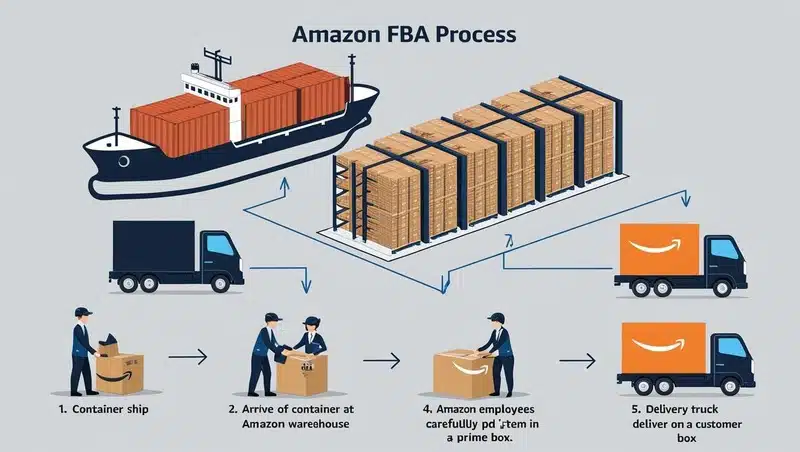
FBA Fee Breakdown Table (2025)
| Fee Type | What It Covers | Typical Range |
| Fulfillment Fee | Picking, packing, shipping your order | $3.22 – $6.27 per unit |
| Referral Fee | Commission on each sale | 8% – 15% of item price |
| Storage Fee (Monthly) | Inventory stored at Amazon’s warehouse | $0.75 – $3.60/cu.ft |
| Long-Term Storage | For items in storage over 365 days | $6.90/cu.ft or $0.15/unit |
| Removal/Disposal Fee | If you remove unsold inventory | Starts at $0.50 per unit |
| Returns Processing | For customer returns (mainly apparel, shoes) | ~$2.12 per return |
📊 Fee estimates based on Amazon U.S. rate card as of January 2025
What Factors Affect Your FBA Costs?
- Product size & weight – Heavier items cost more to fulfill and store
- Sales velocity – Fast-moving items reduce storage fees
- Category – Referral fees vary by category
- Season – Q4 storage fees are 2–3x higher than off-peak months
Recommended Internal Link
Want a deeper breakdown of every Amazon seller fee — including hidden ones?
👉 Amazon Seller Fees Explained
Industry Update
According to the Freightos Baltic Index, ocean freight rates from China to the U.S. West Coast rose by 18% in early 2025 due to post-holiday port congestion.
What does this mean for FBA sellers?
- Always factor freight into your unit cost — especially when launching new products
- Leave 10–14 days of buffer time during Q1 and Q4 peak seasons
Can You Make Money with Amazon FBA?
Yes — but only if you understand the numbers.
FBA is a powerful system, but profits don’t come automatically. Between sourcing costs, FBA fees, advertising, and logistics, you need to build a pricing model that actually works.
Let’s look at how to evaluate profitability step by step.
Step 1: Know Your Unit Economics
Here’s a simplified profit breakdown:
| Cost Item | Example |
| Product Cost (ex-China) | $3.00 |
| FBABEE Freight & Prep | $1.40 |
| FBA Fulfillment Fee | $3.70 |
| Referral Fee (15%) | $2.25 |
| Total Cost | $10.35 |
| Amazon Sale Price | $18.99 |
| Estimated Profit | ~$8.64 |
This kind of margin (~45%) leaves room for PPC spend, small returns, and a sustainable operation.
Step 2: Product Category Matters
Some categories are naturally more profitable, others are risky without scale:
- High-margin examples: supplements, reusable kitchen tools, jewelry
- Low-margin but high-volume: notebooks, phone accessories
- Risky categories: fragile items, large oversize products, seasonal goods
Want to learn more about how to select profitable products?
👉 How to Choose the Right Product for FBA
FBABEE Insight
We worked with a US-based skincare brand that was breaking even after three months on Amazon. Once they bundled two products together, we helped redesign their carton dimensions to reduce dimensional weight.
This cut their FBA fee by $0.90/unit and turned their listing profitable — without changing price or volume.
Other Profit Factors to Watch
- Ad spend: Most new listings need aggressive PPC early on
- Returns: High return rates eat into margin fast
- Storage fees: Sitting inventory = money lost
- Shipment errors: A single mislabel can cost $100+ in rework fees
Mistake to Avoid
Don’t guess your profit — calculate it before you ship. We recommend building a spreadsheet with:
- All landed costs (product + freight + prep)
- Estimated Amazon fees
- Advertising budget
- Desired net margin (e.g. 30%)
If the numbers don’t work, find a better product or adjust your pricing model.
Recommended Tool
You can use Amazon’s FBA Revenue Calculator to plug in your actual numbers and get a real-time profitability estimate.
Amazon FBA vs FBM – Which One is Better?
Amazon gives sellers two main fulfillment options:
- FBA (Fulfillment by Amazon) – You send your inventory to Amazon, and they handle the rest.
- FBM (Fulfilled by Merchant) – You store, pack, and ship your own orders (or use a 3PL).
So which is better? It depends on your product type, business size, and logistics resources.
FBA vs FBM Comparison Table
| Feature | FBA | FBM |
| Storage & Fulfillment | Handled by Amazon | Handled by you or your warehouse |
| Prime Badge | Yes (automatic) | No (unless using SFP) |
| Shipping Speed | 1–2 day Prime shipping | Varies based on your setup |
| Customer Service | Amazon handles everything | You handle it |
| Return Management | Amazon processes returns | You manage returns/logistics |
| Cost Structure | Fulfillment + storage fees | Customizable, but more manual labor |
| Best For | Scalable brands, solo sellers, cross-border | Domestic sellers with in-house ops |
When FBA Makes More Sense
- You’re sourcing from overseas (China, India, Vietnam, etc.)
- You want to tap into Prime buyers
- You don’t have a local warehouse or team
- You plan to scale across multiple products
FBABEE Insight:
For 95% of the sellers we work with — especially those shipping from China — FBA is the obvious choice. Amazon handles all last-mile complexity, and we cover the first-leg.
When FBM Might Be Better
- You sell large or fragile items (e.g. furniture, glassware)
- Your margins are very thin
- You already have a 3PL or warehouse
- You need full control over packaging and branding
Recommended Internal Link
Still unsure which model is right for you? We’ll break it down in detail soon:
👉 FBA vs FBM – How to Choose the Right Fulfillment Model
Who Should Use Amazon FBA (And Who Shouldn’t)
Amazon FBA isn’t for everyone. It’s powerful — but depending on your product type, location, and business model, it might help or hurt your margins.
Here’s how to decide whether FBA is right for you.
FBA is a Great Fit If You Are…
- A beginner seller who wants to scale fast
No warehouse? No problem. FBA takes care of shipping, returns, and customer service. - Sourcing products from China or overseas
With the right partner (like FBABEE), you can go from factory to Amazon warehouse — without touching a single unit. - Selling lightweight, fast-moving products
Items like home goods, stationery, or accessories are cheap to fulfill and less risky to store. - Managing everything solo or with a small team
You offload customer support and warehouse management to Amazon, so you can focus on growth.
FBA May Not Be Right If You Are…
- Selling large, heavy, or oversized products
FBA fees for bulky items can crush your margins. - Very brand-focused or need packaging control
Amazon uses plain boxes unless you’re enrolled in programs like Brand Registry + Premium packaging. - Running a local business with your own warehouse or 3PL
You may save more by fulfilling orders directly — especially with high order volume.
Seller Pro Tip
If you’re unsure whether to commit to FBA for every product, start with a test run. Ship 100–200 units and monitor:
- Sell-through rate
- Return rate
- Review quality
- FBA fees vs. net profit
Then decide whether to scale — or pivot.
Recommended Internal Link
Want to know how to prep your first shipment the smart way?
👉 Amazon FBA Prep Service Guide
Is Amazon FBA Still Worth It in 2025?
FBA has been around for over a decade — but is it still a smart move today?
The answer: Yes, for most sellers.
But it’s no longer the “easy money” opportunity it once was. In 2025, FBA is more competitive, more expensive — and more rewarding if you do it right.
What’s Changed in 2025?
- Fulfillment fees have increased
Amazon raised standard FBA fees by 4–6% across most categories in Q1 2025. - Storage rules are stricter
Units with no sales velocity now get auto-removed or charged long-term storage fees faster than before. - New sellers are still joining
According to Marketplace Pulse, over 1 million new Amazon sellers are expected to launch this year — most of them using FBA.
What Hasn’t Changed
- Prime delivery is still the #1 trust trigger for Amazon buyers
- Amazon’s fulfillment network is unmatched in scale and reliability
- FBA still gives you access to global marketplaces with no local setup
FBABEE Insight
In the last 6 months alone, we’ve onboarded dozens of new FBA sellers — some completely new to ecommerce.
What we’ve learned:
FBA still works, especially if you’re sourcing from China and can control your first-leg logistics.
But sellers who succeed now are the ones who:
- Understand their costs
- Don’t overstock
- Plan freight early (especially in Q4 or pre-CNY)
Real Talk: What I Tell New Sellers
“Amazon FBA still works — but it’s no longer a shortcut. It’s a system.
If you treat it like a real business and build it step-by-step, it can absolutely work for you.
But if you treat it like a ‘money button’, you’ll lose faster than ever.”
Should You Still Use FBA in 2025?
FBA is still worth it if you want scale without the overhead of a warehouse, staff, and support team.
Just make sure you:
- Start small (test product + controlled quantity)
- Work with the right freight and prep partner
- Know your numbers before you click “Send to Amazon”
FAQs About Amazon FBA
Can anyone sell on Amazon FBA?
Yes, as long as you’re at least 18 years old and have a valid ID, bank account, and tax information, you can register as an Amazon seller and use FBA. You don’t need to live in the U.S. — many sellers operate remotely from Europe or Asia.
Do I need a company to start with FBA?
No, you can register as an individual. However, once you scale, switching to a business entity (LLC or LTD) can help with taxes, brand protection, and opening supplier accounts.
Can I start Amazon FBA from China?
Yes — in fact, many sellers do. If you’re sourcing locally, you can use a freight partner like FBABEE to prepare and ship your goods directly to Amazon’s U.S. or EU warehouses.
👉 See our full FBA Prep and Freight from China guide
How much money do I need to start Amazon FBA?
While it varies, most new sellers start with $2,000–$5,000 to cover:
- Inventory (e.g. 200–500 units)
- Product photography and branding
- Freight and prep costs
- Amazon account fees and advertising
Starting with less than $1,500 is possible, but it limits your margin for error.
Do I need to be a U.S. resident to use Amazon FBA US?
No — Amazon supports international sellers. You’ll just need a valid bank account that supports global payouts (like Payoneer or Wise) and someone to handle prep and shipping on your behalf.
Can I use FBA and FBM at the same time?
Yes — this is called a hybrid model. Many sellers list some products via FBA (fast movers) and others via FBM (bulky items or slow sellers).
What are the risks of using FBA?
- Accumulating high storage fees
- Unexpected product removals
- Damaged goods or customer returns
- Delayed check-ins during peak seasons
That’s why it’s critical to understand your numbers and plan shipments carefully.
How long does it take to get started with FBA?
If you already have a product and supplier, setup can be done in 2–4 weeks.
This includes:
- Account registration
- Product sourcing
- Labeling + shipping
- Inbound delivery to Amazon
If you’re sourcing from China, factor in 15–25 days for freight and prep depending on shipping method.
Conclusion: Should You Start with Amazon FBA in 2025?
Amazon FBA has changed — but the opportunity is still real.
If you’re serious about building an ecommerce business, and you’re willing to understand the logistics, do the math, and test products before scaling — then FBA is still one of the best business models in 2025.
It’s not easy. But it’s definitely doable.
What You Should Do Next
Here’s what I recommend, especially if you’re just getting started:
- Choose a simple, lightweight product with proven demand
- Work with a reliable supplier and freight partner (don’t skip quality checks)
- Understand your full unit cost — including prep, shipping, and FBA fees
- Start small. Launch, learn, iterate.
Want Help Shipping to Amazon FBA?
We’ve helped hundreds of sellers ship directly from China to Amazon — without the usual delays, hidden fees, or headaches.
📦 See how we handle it step-by-step →
👉 FBA Freight and Prep Service from China
